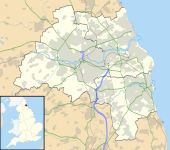Hebburn is a town on the south bank of the River Tyne in North East England situated between the towns of Jarrow and Gateshead and to the south of Walker. The population of Hebburn was 18,808 in 2001, reducing to 16,492 at the 2011 Census for the two Hebburn Wards (North Hebburn and South Hebburn). Once part of the private Ellison estate, and made an independent Urban District in 1894, in 1974 it became part of the metropolitan county of Tyne and Wear. Hebburn lies within historic County Durham.
History
In Saxon times Hebburn was a small fishing hamlet upon the river Tyne. It is thought that the name Hebburn may be derived from the Old English terms, heah meaning "high", and byrgen meaning a "burial mound", though it could also mean the high place beside the water. The first record of Hebburn mentions a settlement of fishermen's huts in the 8th century, which were burned by the Vikings.
In the 14th century the landscape was dominated by a peel tower. A 4-foot-6-inch-tall (137-centimetre) wall, a portion of which still remains at St. John's Church, could also be seen. The Lordship of the Manor of Hebburn passed through the hands of a number of families during the Middle Ages, including the Hodgsons of Hebburn (James 1974, Hodgson).
In the early 1600s, the wealthy Newcastle family, the Ellisons, acquired the land of Hebburn. Coal was mined at Hebburn as early as the 17th century. In 1792 the Ellisons received royalties from coal mining expansion when Hebburn Colliery opened. The colliery eventually operated three pits. In 1786 the Ellisons’ Hebburn estate also made income from dumping ships ballast at Hebburn Quay. By the 1800s the Ellison family had expanded Hebburn Manor into their Hebburn Hall estate. Hebburn Colliery played an important role in the investigations into the development of mine safety, following the mining disaster at Felling Colliery in 1812. Humphry Davy stayed with Cuthbert Ellison at Hebburn Hall in 1815 and took samples of the explosive methan
